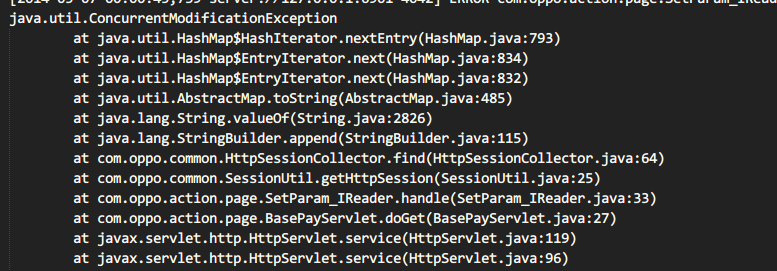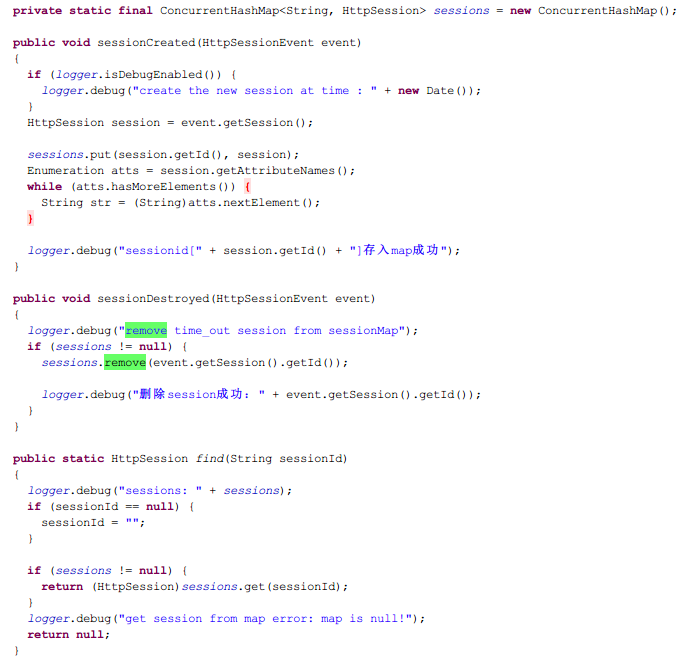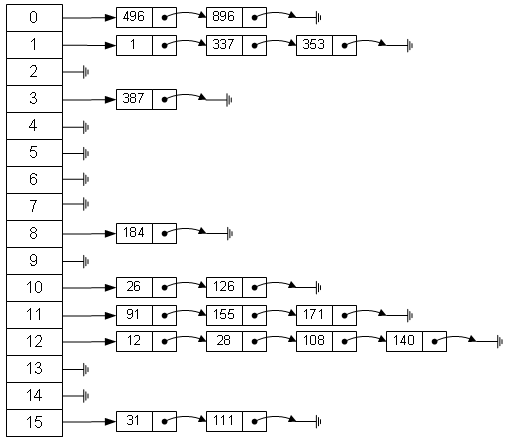记一次HashMap使用不当造成的ConcurrentModificationException
前段时间,支付服务器出现java.util.ConcurrentModificationException异常,是HashMap使用不当导致的,现在将onenote上的日志整理发到博客上。
异常分析
- 异常描述
服务器具体的异常栈信息如下:

其实从异常栈信息,就很明显看到原因了,但是还是有必要根据HashMap的源码分析一次原因,加深印象。接下来,看看修复之后的部分源码 :

ps : 这是修改之后的代码,修改前 sessions为普通的Map,即HashMap。
绿框中的代码是关键部分,从日志来看,报错是在log4j debug方法上:
logger.debug("session: " + sessions);
- HashMap源码分析
从异常栈信息来看,sessions的toString方法被调用,从此入手,HashMap继承了AbstractMap,toString方法是AbstractMap实现的:
public String toString() {
Iterator<Entry<K,V>> i = entrySet().iterator();
if (! i.hasNext())
return "{}";
StringBuilder sb = new StringBuilder();
sb.append('{');
for (;;) {
Entry<K,V> e = i.next();
K key = e.getKey();
V value = e.getValue();
sb.append(key == this ? "(this Map)" : key);
sb.append('=');
sb.append(value == this ? "(this Map)" : value);
if (! i.hasNext())
return sb.append('}').toString();
sb.append(", ");
}
}
首先获取了iterator:
public Set<Map.Entry<K,V>> entrySet() {
return entrySet0();
}
private Set<Map.Entry<K,V>> entrySet0() {
Set<Map.Entry<K,V>> es = entrySet;
return es != null ? es : (entrySet = new EntrySet());
}
private final class EntrySet extends AbstractSet<Map.Entry<K,V>> {
public Iterator<Map.Entry<K,V>> iterator() {
return newEntryIterator();
}
public boolean contains(Object o) {
if (!(o instanceof Map.Entry))
return false;
Map.Entry<K,V> e = (Map.Entry<K,V>) o;
Entry<K,V> candidate = getEntry(e.getKey());
return candidate != null && candidate.equals(e);
}
public boolean remove(Object o) {
return removeMapping(o) != null;
}
public int size() {
return size;
}
public void clear() {
HashMap.this.clear();
}
}
调用entrySet,返回EntrySet,然后调用它的iterator()方法,返回迭代器:
Iterator<Map.Entry<K,V>> newEntryIterator() {
return new EntryIterator();
}
从这里可以看出,每次调用iterator()方法,都会返回一个新的迭代器。再来看看EntryIterator迭代器的实现:
private final class EntryIterator extends HashIterator<Map.Entry<K,V>> {
public Map.Entry<K,V> next() {
return nextEntry();
}
}
EntryIterator继承于HashIterator,实现了next()方法,也就是说,当调用HashMap的toString方法时,迭代器的next方法是这个。ok,继续看next()方法,调用了nextEntry() :
final Entry<K,V> nextEntry() {
if (modCount != expectedModCount)
throw new ConcurrentModificationException();
Entry<K,V> e = next;
if (e == null)
throw new NoSuchElementException();
if ((next = e.next) == null) {
Entry[] t = table;
while (index < t.length && (next = t[index++]) == null)
;
}
current = e;
return e;
}
终于找到了ConcurrentModificationException异常,源码暂且分析到这里,先来看看一个示例。
- 示例分析
public class TestMap {
public static void main(String[] args) {
Map<String, String> map = new HashMap<String, String>();
map.put("key", "value");
map.put("key1", "values");
Iterator<Map.Entry<String, String>> iterator = map.entrySet().iterator();
System.out.println(iterator);
map.remove("key");
// iterator = map.entrySet().iterator();
// System.out.println(iterator);
if (iterator.hasNext()) {
System.out.println(iterator.next().getKey());
}
}
}
先把24行和25行注释掉,运行这段代码:
Exception in thread "main" java.util.ConcurrentModificationException
java.util.HashMap$EntryIterator@3d4b7453
at java.util.HashMap$HashIterator.nextEntry(HashMap.java:793)
at java.util.HashMap$EntryIterator.next(HashMap.java:834)
at java.util.HashMap$EntryIterator.next(HashMap.java:832)
at com.demo.map.TestMap.main(TestMap.java:27)
然后把24行和25行打开:
java.util.HashMap$EntryIterator@41d5550d
java.util.HashMap$EntryIterator@1cc2ea3f
key1
一切正常。 问题出在remove上:
public V remove(Object key) {
Entry<K,V> e = removeEntryForKey(key);
return (e == null ? null : e.value);
}
/**
* Removes and returns the entry associated with the specified key
* in the HashMap. Returns null if the HashMap contains no mapping
* for this key.
*/
final Entry<K,V> removeEntryForKey(Object key) {
int hash = (key == null) ? 0 : hash(key.hashCode());
int i = indexFor(hash, table.length);
Entry<K,V> prev = table[i];
Entry<K,V> e = prev;
while (e != null) {
Entry<K,V> next = e.next;
Object k;
if (e.hash == hash &&
((k = e.key) == key || (key != null && key.equals(k)))) {
modCount++;
size--;
if (prev == e)
table[i] = next;
else
prev.next = next;
e.recordRemoval(this);
return e;
}
prev = e;
e = next;
}
return e;
}
直接调用remove,会使得modCount++,而modCount的作用,可以参考javadoc:
/**
* The number of times this HashMap has been structurally modified
* Structural modifications are those that change the number of mappings in
* the HashMap or otherwise modify its internal structure (e.g.,
* rehash). This field is used to make iterators on Collection-views of
* the HashMap fail-fast. (See ConcurrentModificationException).
*/
transient volatile int modCount;
- 结论
看完示例代码,再回到next()方法,可以看到HashMap的remove方法,并没有修改expectedModCount(该变量是调用HashIterator构造函数时,被设置为modCount的),从而导致异常发生。 再回来看看线上代码,一个线程会调用log.debug()方法,进入Map的toString()方法,会生成新的Iterator对象,进而调用next()方法,如果此时另外有线程sessionDestoryed()方法,而sessions又是类成员,调用HashMap的remore方法,异常就这样爆出来了。
扩展
- 整个过程分析下来,对HashMap的结构有了更深的了解,从网上找来一张HashMap的结构图,加深印象:

- HashMap在并发环境下使用,其实还有另外一种更严重的坑,会导致CPU飙升,具体可以看看耗子叔的酷壳, 然后,就在前几天,线上居然真的发现CPU飙升的代码,真的是无处不在的坑啊。